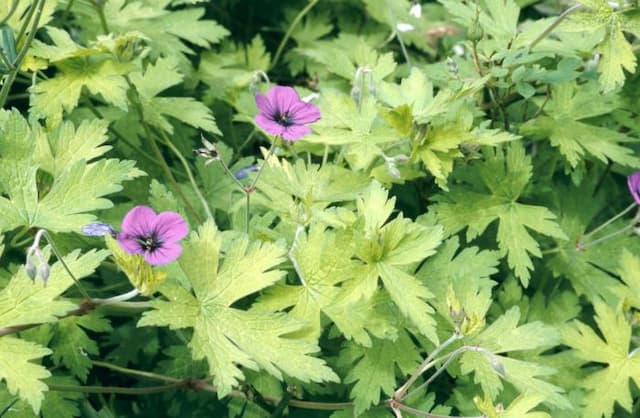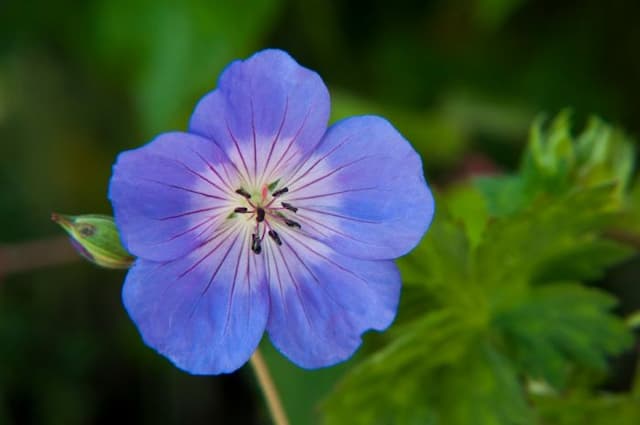Purple Cranesbill Geranium × magnificum

ABOUT
The plant known as the Geranium × magnificum, or more commonly as the Showy Geranium, has a lush and spreading appearance, typically producing an impressive display. This perennial bears deeply lobed, velvety leaves which are rich green in color and give off a fragrant scent when crushed. During its blooming period, it becomes particularly eye-catching due to its profusion of vivid, violet-blue flowers. These flowers are saucer-shaped with fine veining and a paler center, often with a small white eye that adds contrast to the overall floral display. The blooms are arranged in loose clusters and can create a spectacular show, which is not only visually appealing but also attracts a variety of pollinators, including bees and butterflies. The flowering season usually occurs in late spring to early summer, making it a beautiful addition to any garden during this time. After the blooms have passed, the geranium's foliage continues to provide a lush backdrop for other summer-flowering plants. As the seasons change, the green leaves may develop reddish hues, adding another layer of interest to the garden.
About this plant
 Names
NamesFamily
Geraniaceae
Synonyms
Showy Geranium, Purple Cranesbill
Common names
Geranium platypetalum var. krameri, Geranium asphodeloides.
 Toxicity
ToxicityTo humans
Purple Cranesbill (Geranium × magnificum) is not known for being toxic to humans. Most species of Geranium are considered non-toxic and don't typically cause adverse effects if ingested. However, if large quantities are consumed, it may cause gastrointestinal discomfort as it's not part of the human diet. Always exercise caution and consult a medical professional if ingestion occurs and symptoms develop.
To pets
Purple Cranesbill (Geranium × magnificum) is also not known for being toxic to pets. It is generally considered safe around pets, and there are no significant reports of poisoning in animals from ingestion. Nevertheless, it is always prudent to prevent pets from eating plants, as individual sensitivities may vary, and ingesting non-food items can sometimes lead to gastrointestinal upset or other issues. If you suspect your pet has ingested a large amount of the plant and is showing adverse symptoms, contact your veterinarian.
 Characteristics
CharacteristicsLife cycle
Perennials
Foliage type
Deciduous
Color of leaves
Green
Flower color
Violet
Height
1-2 feet (30-60 cm)
Spread
1-2 feet (30-60 cm)
Plant type
Herb
Hardiness zones
4
Native area
Asia Minor
Benefits
 General Benefits
General Benefits- Aesthetic Appeal: The plant's vibrant purple-blue flowers and attractive foliage enhance garden design and provide visual interest throughout the blooming season.
- Attracts Pollinators: Geranium × magnificum is known to attract pollinators such as bees, which is beneficial for the pollination of nearby plants and overall garden health.
- Low Maintenance: This geranium is relatively low maintenance, requiring minimal care beyond basic watering and occasional pruning to remove spent flowers.
- Drought Tolerance: Once established, it has good drought tolerance, making it suitable for gardens with less frequent watering schedules.
- Rapid Growth: The plant has the ability to grow quickly and cover ground, which can help suppress weeds and reduce garden maintenance.
- Hardiness: It is a hardy perennial, capable of surviving through cold winters in many climates, making it a reliable performer year after year.
 Medical Properties
Medical PropertiesThis plant is not used for medical purposes.
 Air-purifying Qualities
Air-purifying QualitiesThis plant is not specifically known for air purifying qualities.
 Other Uses
Other Uses- Crafting natural dyes: The petals of Geranium × magnificum can be used to create a range of natural dyes for fabrics or papers, providing a sustainable alternative to synthetic dyes.
- Garden borders: This plant is often used in garden design to create attractive borders along pathways or garden beds due to its dense foliage and striking blooms.
- Companion planting: Gardeners plant Geranium × magnificum alongside roses and other susceptible plants to help deter common pests with its aromatic leaves.
- Educational tool: The plant can be used in educational settings to teach children about pollination, as it attracts a variety of pollinators like bees and butterflies.
- Flower arranging: Fresh or dried flowers of the Geranium × magnificum can be used in floral arrangements for their vibrant colors and longevity.
- Photography subject: With its vivid purple flowers, the plant provides an excellent subject for photography, ideal for botanical prints and calendars.
- Aromatherapy: The fragrant leaves can be used for their scent in potpourris and sachets to naturally freshen up a room.
- Liquid feed: Geranium × magnificum can be used as a component in compost tea or liquid fertilizers, giving other plants a nutrient boost.
- Biodegradable décor: During events, the leaves and petals of Geranium × magnificum serve as biodegradable confetti or decorative elements that are more eco-friendly than synthetic alternatives.
- Wildlife habitat: This hardy geranium species can be included in wildlife garden designs to provide shelter and nourishment for beneficial insects and birds.
Interesting Facts
 Feng Shui
Feng ShuiThe Hardy Geranium is not used in Feng Shui practice.
 Zodiac Sign Compitability
Zodiac Sign CompitabilityThe Hardy Geranium is not used in astrology practice.
 Plant Symbolism
Plant Symbolism- Foolishness: Geraniums are associated with foolishness or stupidity in the language of flowers, perhaps because of the bright and sometimes overwhelming colors that might not align with more refined tastes.
- Friendship: As with many flowers, geraniums can symbolize a connection or bond between friends, often translating to a wish for good health and happiness for one's companions.
- Ingenuity or Cleverness: The diverse and adaptive nature of geraniums—thriving in various conditions—can make them a symbol of resourcefulness and problem-solving abilities.
- True Friendship: Some cultures associate geraniums with the purity and depth of true friendship, reflecting the plant's enduring nature and perennial growth.
- Peace: The soothing appearance of Geranium × magnificum, with its lush foliage and gentle hues, can be a symbol of tranquility and calmness, representing a desire for peace and serenity in one's life.
 Water
WaterThe Purple Cranesbill, commonly known as Geranium × magnificum, should be watered deeply once a week, allowing the soil to dry out slightly between waterings. During hot or dry weather, increase the frequency to twice a week, providing about one gallon of water per plant each time. Be sure to water directly at the soil level to avoid wetting the foliage, as this can lead to fungal diseases. During the winter, when the plant is dormant, reduce watering to every other week or whenever the soil feels dry to the touch.
 Light
LightPurple Cranesbill thrives in full sun to partial shade. The best spot for this plant is one where it can receive at least four to six hours of direct sunlight daily, but is also protected from the harsh afternoon sun, especially in hotter climates. Dappled shade in the afternoon can help prevent the foliage from scorching.
 Temperature
TemperatureThe Purple Cranesbill prefers moderate temperatures and can typically survive in USDA hardiness zones 4 to 8. It can tolerate minimum temperatures down to around -30 degrees Fahrenheit, but the ideal temperature range for vigorous growth is between 60 and 70 degrees Fahrenheit. Extreme heat above 85 degrees Fahrenheit can be stressful for the plant, so provide some shade during the hottest parts of the year.
 Pruning
PruningPurple Cranesbill should be pruned to remove spent flowers and encourage a second bloom. Deadheading, or cutting back the flowered stems to a leaf node, can be done throughout the blooming season. After the first major bloom, cutting the plant back by half its size can stimulate new growth and a second wave of flowers. The best time for major pruning is late summer or early fall.
 Cleaning
CleaningAs needed
 Soil
SoilThe best soil mix for Hardy Geranium is well-draining with plenty of organic matter. A mix of two parts garden soil, one part peat moss or compost, and one part perlite or coarse sand works well. The ideal soil pH for Hardy Geranium should be slightly acidic to neutral, ranging from 5.8 to 7.2.
 Repotting
RepottingHardy Geranium does not typically require frequent repotting and can thrive in the same pot for several years. Generally, repotting every 3-4 years is sufficient unless the plant shows signs of distress or outgrowing its container.
 Humidity & Misting
Humidity & MistingHardy Geranium prefers moderate humidity levels but is quite adaptable and can tolerate the average humidity found in most homes and gardens without any special requirement.
 Suitable locations
Suitable locationsIndoor
Place in bright, indirect light and ensure pot has drainage holes.
Outdoor
Plant in part shade to full sun in well-draining soil.
Hardiness zone
4-8 USDA
 Life cycle
Life cycleGeranium × magnificum, commonly known as the showy geranium, starts its life cycle as a seed which, when conditions are right, germinates into a young seedling. The seedling grows into a mature plant with a strong root system and a rosette of leaves close to the ground. When mature enough, typically in late spring to early summer, the showy geranium produces clusters of vibrant blue to violet flowers with veined petals that attract pollinators. After pollination, the flowers develop into fruit capsules containing seeds, which are dispersed by wind or animal activity to propagate the next generation of plants. Throughout the growing season, the plant continues to produce foliage and may bloom repeatedly. As a perennial, it dies back to its robust root system in the winter to survive the cold, then regenerates and starts the cycle anew in the spring.
 Propogation
PropogationPropogation time
Spring-Early Summer
Propogation: The most popular method of propagation for the Geranium × magnificum, commonly known as the showy geranium, is by division. This is usually done in the spring or early fall. To propagate by division, carefully dig up an established clump of the plant and gently separate it into smaller sections, ensuring that each section has a piece of the root system. It's essential to use a sharp, clean tool to minimize damage to the roots. Once divided, the new plants should be immediately replanted in well-draining soil, spaced about 12 to 24 inches apart to allow sufficient room for growth. Water thoroughly after planting to help establish the new divisions.









